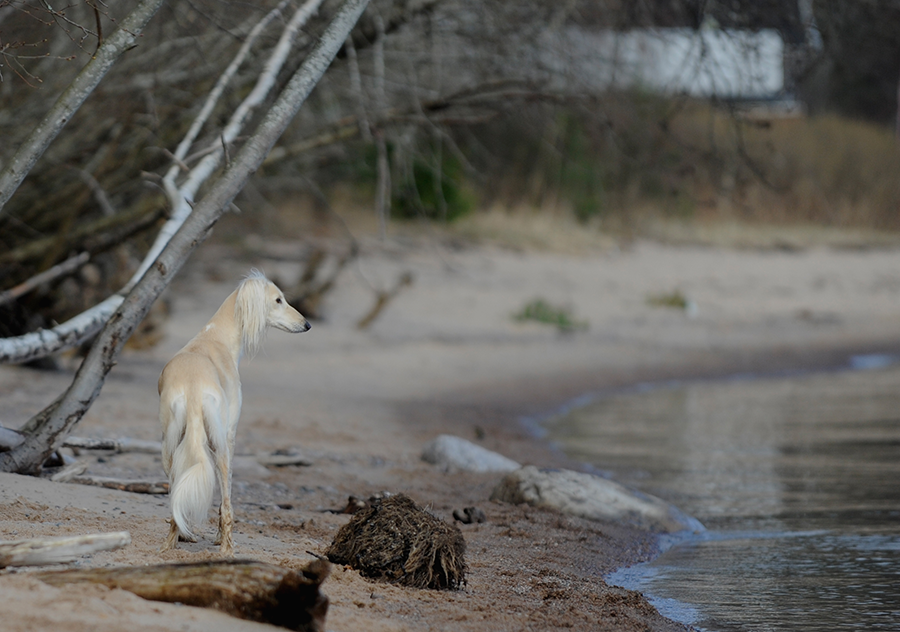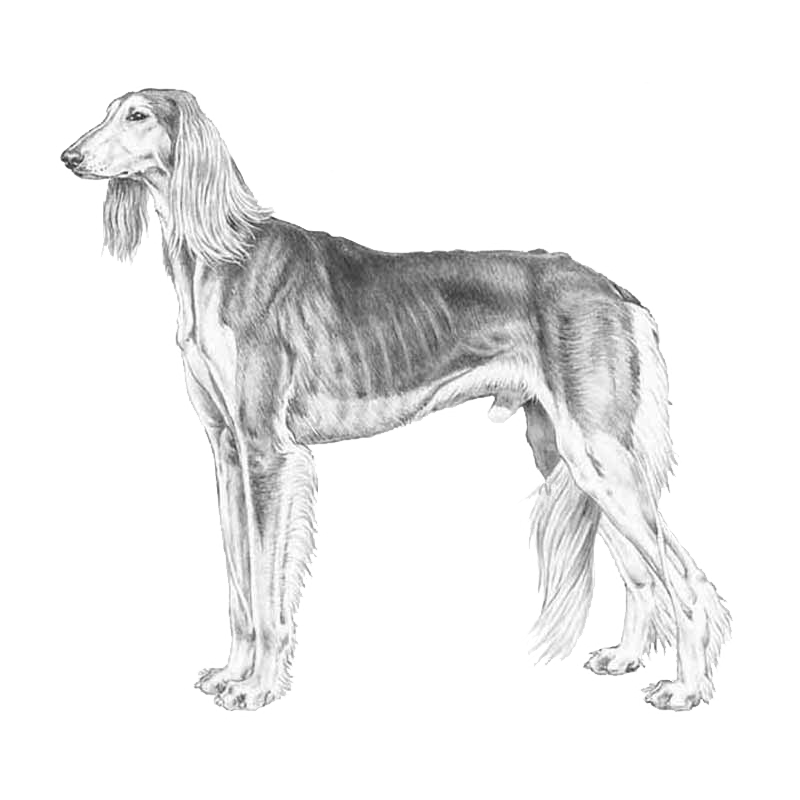- Brief Description
The whole appearance of this breed should give an impression of grace and symmetry and of great speed and endurance coupled with strength and activity. Smooth variety: the points should be the same with the exception of the coat which has no feathering. Reserved with strangers, but not nervous or aggressive. Dignified, intelligent and independent.
- Links to Breed Descriptions
Society for the Perpetuation of Desert Bred Salukis: https://desertbred.org/
This society is committed to protect all aspects of the genetic diversity of the Saluki breed, especially through the perpetuation of registered country of origin Salukis.
PBS: Nature: Speedy Saluki For 6,000 years, the Bedouin have bred Saluki for speed.
AKC Video (link - https://youtu.be/CDNFItkWSZQ
View more videos on AKC's YouTube Channel: https://www.youtube.com/user/AmericanKennelClub
- Other Names for Breed
- Country of Origin and Parent Breed Club
Country of origin: Middle East
- Health and Well-Being
Some sources of health information include:
- National kennel clubs and breed clubs (see, e.g. Breeding/Health Strategy Documents, below)
- Population-level statistics (see, e.g., Swedish Insurance Data, below)
- Research articles
- Breed club surveys
- Breed-Specific Articles
 Get a GRIHP! on Salukis
Get a GRIHP! on Salukis
This article on Salukis is part of a series to highlight the Big Picture of health, welfare and breeding and to help develop Globally Relevant Integrated Health Profiles (GRIHPs) for many breeds. See IPFD's Get a GRIHP! on Breed Health Initiative. PLEASE NOTE: This installment is just the beginning...we will add further statistics and information as they become available.
This booklet contains general breed information.
Author: Ken Allan, a leading breeder and supporter of the breed.
The following Saluki health articles are provided by David Steel.
BREEDING FOR FUNCTION
Alternative perspective on Salukis - trying to look beyond the breed standards, thought provoking for anyone looking at breeding
"Adapted with permission from SALUKI INTERNATIONAL Spring/Summer 1994
This article has also appeared in Field Advisory News, November/December 1993,
and in SCOA News, the newsletter of the Saluki Club of America, Spring 1994
The functional Saluki - lessons from the coursing field By DAN BELKIN, Ph.D.
Based on the seminar given at the Saluki Club of America National Specialty, June 11 1993
Taped, transcribed and edited by Vicky Clarke, with additions and editing by Dan Belkin
This Web page version was created by John Burchard"ARTICLE: INHERITED DISEASE: HELEN AIMS
1.8 MB
A view of inherited diseases in Salukis - dates from 1993 and is based on Agria/Sweden data…could be useful to compare with current data.
NEUROLOGICAL
 • Ceroid-lipofuscinosis in two Saluki dogs--E.C. Appleby, J.A. Longstaffe, F.R. Bell.pdf 3.7 MB
• Ceroid-lipofuscinosis in two Saluki dogs--E.C. Appleby, J.A. Longstaffe, F.R. Bell.pdf 3.7 MB
1982 paper on NCL ….very topical still and an area that I suggest we should get some global input on as there are various reported incidences appearing in a number of countries. The challenge we face is the scale of the breed means we will be a low priority in the development of a genetic test, so maybe climbing together we can do something?
ABSTRACT
Two 2-year-old Saluki dogs from related litters developed nervous signs from 1 year of age and showed inco-ordination, swimming movements and inability to stand.
The principal pathological finding was the presence of intracytoplasmic, lipoid pigment masses in large neurones of the brain, retina and enteric ganglia. The pigment was autofluorescent, stained positively with Sudan Black and Luxol Fast Blue and with HE staining resembled ceroid. Electron micrography showed membrane-bound masses of laminar inclusions in patterns of whorls or bundles in the cytoplasm of neurones.
The clinical history and pathological appearances resemble those of an inheritable type of neuronal ceroid-lipofuscinosis (juvenile familial amaurotic idiocy, Batten's disease) described in man and in the English Setter. This is believed to be the first report in the Saluki breed.
The nature of the condition and its possible cause are briefly discussed in the light of published research.
Source: http://dx.doi.org/10.1016/0021-9975(82)90022-6
Editor's Note: see other disease, breed-specific information/research:
A Variant Form of Neuronal Ceroid Lipofuscinosis in American Bulldogs
Neuronal Canine Ceroid Lipofuscinosis Basics
ENDOCRINE
Canine Thyroid and Autoimmune Disease: Dr. Jean Dodds
- CANINE THYROID AND AUTOIMMUNE DISEASE - Genetics, nutrition, vaccine-related issue.pdf (2000) 5.5 MB
This article is also available online at scribd:
MUSCULAR
Myasthenia Gravis Grave Muscle Disease - Dr Janet Lalonde.pdf 2 MB
CANCER Hemangiosarcoma - Shakir.pdf 1.8 MB
Hemangiosarcoma by one of our owners in the UK who has been through it with one of their dogs. It may not help much, but is a good owner perspective and good to have a less clinical view!
HEARTHeart of the Matter.pdf 196 KB
Saluki Heart Research - Saluki World Congress 2008.pdf 3.2 MB
Salukis With Broken Hearts 199X.pdf 1.8 MB
Articles on heart issues: This has been an area of great focus in Salukis and the articles from Mary Dee Sist are very good snapshots over time. - Breed Standards
There are numerous breed standards.
The basis of breed/conformation shows is the judging of pedigree dogs against the 'Breed Standard', which is a picture in words that describes the range of features that are deemed appropriate for the breed.
Three of the major international standards are:
- Breed-Specific Statistics
1. Swedish Insurance Data
- Breed-specific information on rates of disease and death from Agria Pet Insurance (Agria Djurförsäkring) is available for many breeds.
This breed has information on Veterinary Care events.2. The Breed Archive (International): https://breedarchive.com/home/index (includes several breeds: Azawakh, Finnish lapphund, Italian greyhound, Saluki and Whippet)
The Saluki listing https://saluki.breedarchive.com/ includes 54650 Dogs, with saluki data from multiple countries - note that registration numbers recorded by KCs and number of dogs in this DB do not mirror each other. This Database contains records for Dogs, Persons, Statistics, Colour distribution, Health, Population, Popular sires. - Breeding/Health Strategy Documents
Health/Breeding Strategy Documents and Links:
- The Kennel Club, UK: Category 1: https://www.thekennelclub.org.uk/search/breeds-a-to-z/breeds/hound/saluki/
- Sweden: Breed-specific Breeding Strategies: (in Swedish) and/ or English summary
- Finland: Breed-specific Breeding Strategies (JTO): English summary
- UK: The Saluki Club UK, Health: http://www.salukiclub.co.uk/the-breed/health
Page includes links to breed health information, health management tools, health research as well as a Health Survey - 2013 - (Internal - FinalReportSalukiHealthLogo.pdf)
Sweden: Heart screening results
Health Surveys
Finland: Summaries of health surveys in Saluki magazines: https://www.saluki.fi/kasvatus/terveystutkimukset/terveystulokset/
- Breed-Specific DNA Tests
- Other Breed-Specific Webpages
Saluki Welfare - an organisation set up by breeders in the 60’s to take care of Salukis that could not be looked after by their owners; also provides some support in terms of healthcare.
- Breed-Specific Research

Saluki Studies supported by Saluki Health Research, Inc.
In addition to Health Research information, Health Conference reports and health articles are available.
The document below was prepared by MaryDee Sist, DVM for the Saluki World Congress in Helsinki, Finland, June 2008
- Breed Clubs
We are listing sites for breed clubs with health or other information that might be helpful. Follow links below.
Finland: Suomen Salukikerho Ry. http://www.saluki.fi/
UK: Saluki or Gazelle Hound Club http://www.salukiclub.co.uk
The Northern Saluki Club: http://www.northernsalukiclub.co.uk
Sweden: Svenska Salukiringen: https://www.saluki.se/index.php/sv/:
English: https://www.saluki.se/index.php/en/Germany: Deutscher Windhundzucht- und Rennverband e.V.: https://www.windhundverband.de/rassen/saluki/
Salukis vary in type and the variation is desired and typical for the breed. The reason for the variation is the special place held by the Saluki in the Arab tradition and the immense size of the Middle East area where the Saluki has been used as a hound of the chase for thousands of years.
Photo: Jessica Bolander, emoticon.se






Recommended Comments
Please sign in to comment
You will be able to leave a comment after signing in
Sign In Now